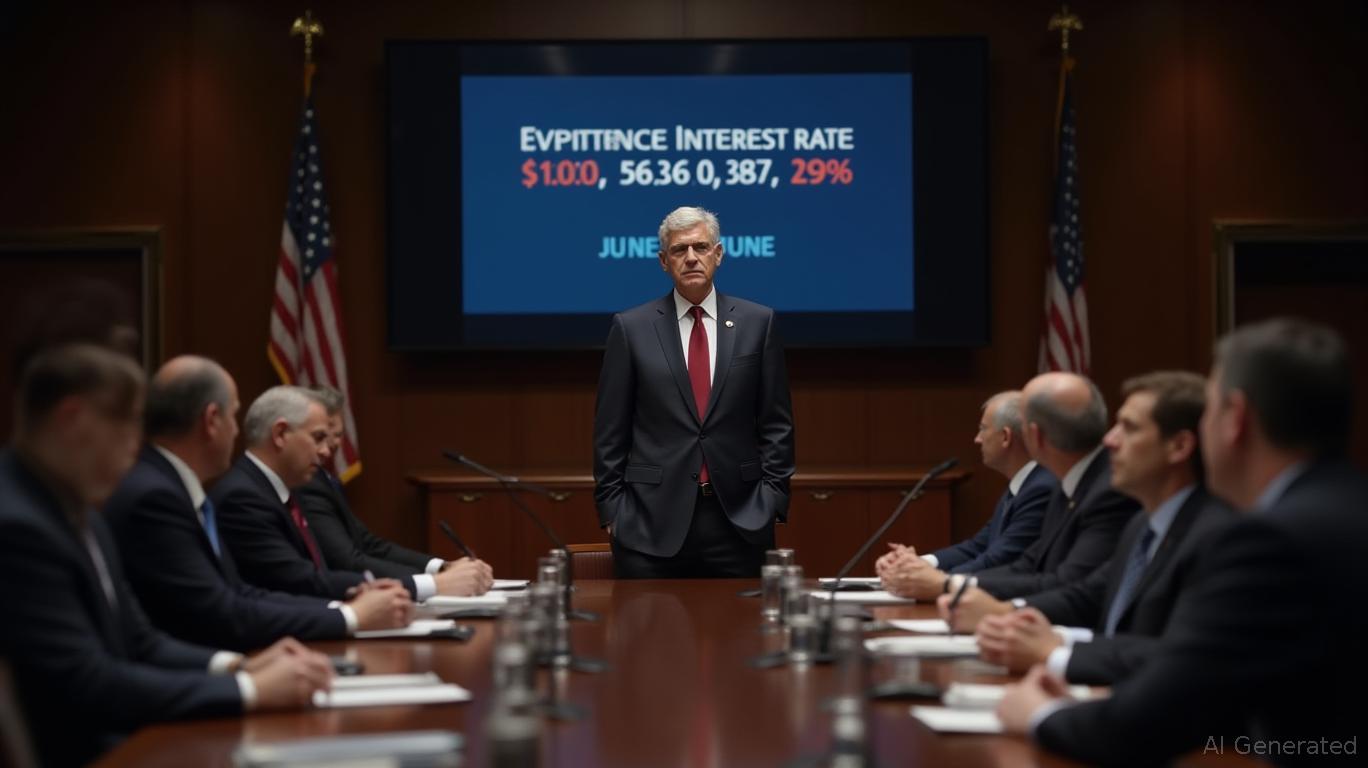Federal Reserve Maintains Rates, Projects Two Cuts by Year-End
Epic EventsWednesday, Jun 18, 2025 10:10 pm ET
The Federal Reserve's decision to hold interest rates steady for the fourth consecutive meeting is a critical development for financial markets, amidst ongoing economic uncertainty. This decision arrives as the U.S. navigates trade policy impacts and potential inflationary pressures.
Introduction
The Federal Reserve's interest rate decision underscores the delicate balance policymakers face amidst conflicting signals from the economy. The Fed's choice to maintain the federal funds rate in the 4.25% to 4.50% range reflects a cautious approach, given the persistent inflation risks and steady labor market conditions. Despite a stable economy, the forecast of two rate cuts by year-end suggests the Fed's readiness to adapt as new data emerges, particularly in response to tariff-induced inflation concerns.
Data Overview and Context
Interest rates serve as a pivotal tool for monetary policy, influencing economic growth and investment decisions. The Fed's current target is to maintain rates between 4.25% and 4.50%, unchanged since January. Historically, these rates have fluctuated based on economic conditions, with the last cut occurring in December 2024. The Fed relies on various indicators, including employment statistics and inflation measures, to guide its decisions. Given the elevated uncertainty, the Fed's projections are inherently speculative, subject to revisions as new data becomes available.
Analysis of Underlying Drivers and Implications
Key factors influencing the Fed's rate decision include the Trump administration's tariff policies, which are expected to elevate inflation. The tariffs pose a risk of increased prices for consumers, potentially slowing economic growth. Despite these pressures, the labor market remains robust, with unemployment at 4.2%. The interplay between these elements suggests a cautious outlook, with the Fed forecasting inflation to rise to 3% by year-end.
Policy Implications for the Federal Reserve
The Fed's decision to maintain interest rates reflects its cautious stance amidst uncertain economic conditions. Policymakers aim to balance inflation control with economic growth, highlighting the importance of monitoring tariff impacts. The Fed's projection of rate cuts later in the year aligns with its strategy to mitigate potential economic slowdowns while addressing inflation risks.
Market Reactions and Investment Implications
The Fed's rate decision has significant implications for various asset classes. Fixed income markets may experience stability, with Treasury yields reflecting the unchanged policy stance. Equities could benefit from continued low borrowing costs, while currencies might see volatility as investors assess inflation risks. Commodity markets, particularly oil, may react to geopolitical tensions influencing energy prices. Investors are advised to monitor sector-specific developments, especially in industries sensitive to interest rate changes.
Conclusion & Final Thoughts
The Federal Reserve's decision to hold rates steady while forecasting future cuts illustrates its cautious approach amid economic uncertainty. This policy stance reflects the Fed's commitment to balancing inflation control with growth. As markets digest the implications, attention will turn to upcoming data releases, including inflation reports, which will provide further insights into the Fed's policy trajectory. Investors should remain vigilant, considering the potential impacts on various asset classes and preparing for potential shifts in economic conditions.
Introduction
The Federal Reserve's interest rate decision underscores the delicate balance policymakers face amidst conflicting signals from the economy. The Fed's choice to maintain the federal funds rate in the 4.25% to 4.50% range reflects a cautious approach, given the persistent inflation risks and steady labor market conditions. Despite a stable economy, the forecast of two rate cuts by year-end suggests the Fed's readiness to adapt as new data emerges, particularly in response to tariff-induced inflation concerns.
Data Overview and Context
Interest rates serve as a pivotal tool for monetary policy, influencing economic growth and investment decisions. The Fed's current target is to maintain rates between 4.25% and 4.50%, unchanged since January. Historically, these rates have fluctuated based on economic conditions, with the last cut occurring in December 2024. The Fed relies on various indicators, including employment statistics and inflation measures, to guide its decisions. Given the elevated uncertainty, the Fed's projections are inherently speculative, subject to revisions as new data becomes available.
Analysis of Underlying Drivers and Implications
Key factors influencing the Fed's rate decision include the Trump administration's tariff policies, which are expected to elevate inflation. The tariffs pose a risk of increased prices for consumers, potentially slowing economic growth. Despite these pressures, the labor market remains robust, with unemployment at 4.2%. The interplay between these elements suggests a cautious outlook, with the Fed forecasting inflation to rise to 3% by year-end.
Policy Implications for the Federal Reserve
The Fed's decision to maintain interest rates reflects its cautious stance amidst uncertain economic conditions. Policymakers aim to balance inflation control with economic growth, highlighting the importance of monitoring tariff impacts. The Fed's projection of rate cuts later in the year aligns with its strategy to mitigate potential economic slowdowns while addressing inflation risks.
Market Reactions and Investment Implications
The Fed's rate decision has significant implications for various asset classes. Fixed income markets may experience stability, with Treasury yields reflecting the unchanged policy stance. Equities could benefit from continued low borrowing costs, while currencies might see volatility as investors assess inflation risks. Commodity markets, particularly oil, may react to geopolitical tensions influencing energy prices. Investors are advised to monitor sector-specific developments, especially in industries sensitive to interest rate changes.
Conclusion & Final Thoughts
The Federal Reserve's decision to hold rates steady while forecasting future cuts illustrates its cautious approach amid economic uncertainty. This policy stance reflects the Fed's commitment to balancing inflation control with growth. As markets digest the implications, attention will turn to upcoming data releases, including inflation reports, which will provide further insights into the Fed's policy trajectory. Investors should remain vigilant, considering the potential impacts on various asset classes and preparing for potential shifts in economic conditions.

Disclaimer: The news articles available on this platform are generated in whole or in part by artificial intelligence and may not have been reviewed or fact checked by human editors. While we make reasonable efforts to ensure the quality and accuracy of the content, we make no representations or warranties, express or implied, as to the truthfulness, reliability, completeness, or timeliness of any information provided. It is your sole responsibility to independently verify any facts, statements, or claims prior to acting upon them. Ainvest Fintech Inc expressly disclaims all liability for any loss, damage, or harm arising from the use of or reliance on AI-generated content, including but not limited to direct, indirect, incidental, or consequential damages.

Comments
No comments yet